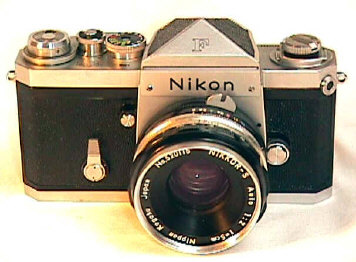 The Nikon F's Place in History
The Nikon F's Place in History The Nikon F's Place in History
The Nikon F's Place in HistoryThe Nikon F is arguably the most significant SLR in 35mm history. Introduced in March 1959, the F immediately became Nikon's best seller and established Nikon as the Professional's 1st choice.
Background
This was a real turn around folks, and to understand it, we will have to look at 35mm photography in 1959. While the Japanese were the up and coming new boys on the block, everyone knew that the Germans were the undisputed leaders. Leica was far and away the best selling professional Rangefinder camera. Rollei's TLR was the pro's choice in 120 cameras. And then of course there were the marvelously sharp Zeiss optics on the awkward but superlatively made Contax and Contarex. Japan was where the cheap cameras came from. You bought Japanese if you couldn't afford German.
SLR's? 35mm SLR's were generally slow working cameras with no instant return mirrors and no automatic diaphragm. Don't know what I'm talking about? After an exposure, the mirror on most 35mm SLR's did not return into viewing position until you advanced the film. In other words, you were stuck looking at a black hole. The instant return mirror came to market on the Asahiflex IIb of 1953--but not everyone was quick to adapt it. And then there was the little matter of the lens diaphragm. If you had just taken a picture at f/16 and you were lucky enough to be using a camera with an instant return mirror, you still didn't have a clear view after the exposure because the camera lens was still at f/16. The bright image you had was now dim, until you manually opened up your lens to its maximum aperture. Until automatic diaphragm lenses for SLRs started showing up. They would automatically open the lens back up to its maximum aperture after exposure.
Manufacturer after manufacturer in the late 50's kept introducing their idea of the SLR of the future, with all the bells and whistles. While some of them, notably Pentax, seemed to be on the right track, none of them really had a Professional 35mm SLR, UNTIL THE NIKON F. Strangely enough the March 1959 Philadelphia photo show saw the US introduction of three new top brand Japanese SLR lines: the Minolta SR-2 with 55/1.8 and a list price of $249.50, the Canon Canonflex with 50/2 and a list price of $299.95, and the Nikon F with a 50/2 had a list price of 359.50.
The Nikon F completely eclipsed everything else in its time as a Pro 35. Professionals switched from the Leica M's (and everything else) to Nikon F's in legions, and to this day Leica has never recovered. But more than the Professional's switch from Leica to Nikon, it also signaled the maturity of the Japanese photo industry.
From that time on, Japan was the new Photographic Industry leader and Germany would be doomed to play catch up. Zeiss got out of the camera business. Rollei hangs on bought out by Samsung. Leica continues its post Leitz family experience once having been owned by a concrete manufacturer and now has new ties to Yashica.
The Nikon F was a really big deal, a crucial turning point in 35mm Photography.
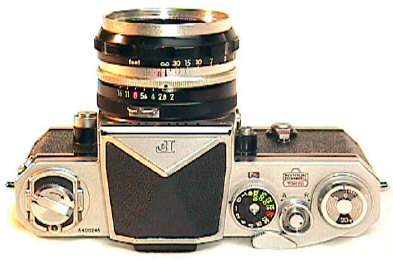
Notice the early serial # of this camera, and the "Nippon Kogaku" logo which was later replaced with "Nikon." Pictured is the plain meterless prism finder. As F Photomics of various models fail with without replacement parts, the smaller prism finder has found new life and popularity. Today, F prism finders are worth more than the Photomics.
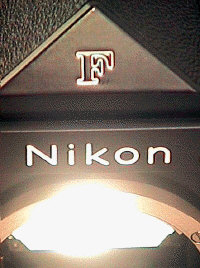 The Nikon F
The Nikon F
For any product to re-define an industry, it has to be quite a product.
The Nikon F brought together all the best elements of 35 SLRs for the first time. Far ahead of its contemporaries, literally nothing could compare to it. Photographers switched to it in droves. Its best elements included:
The first 35 motorized SLR that could have an portable electric motor drive attached to every body. It was also the fastest motor drive at a blazing 4 frames per second with the mirror locked up. Although the Zunow and Minolta SR-2 were announced with motor drives before the F, they never made it to production.
First Japanese SLR to have a lens lineup from 21mm to 1000mm (from day 1!). The F was introduced with the 21/4, 28/3.5, 35/2.8, 50/2, 105/2.5 and 135/3.5. The longer lenses were the 180/2.5, 250/4, 500/5 from the already established Nikon Rangefinder lineup. These longer lenses were usable with the NF adapter.
First 35 SLR with 100% Viewfinder. The F was the first to offer this feature, and very few professional cameras have chosen to equal it due to the extra precision and cost involved in manufacture.
First Japanese SLR with Mirror lock up, possibly the first 35 SLR with mirror lockup.
First Japanese SLR with interchangeable focusing screens. Nikon provided a wide choice of interchangeable focusing screens so the photog could easily choose the best focusing screen for the job.
First Japanese SLR to offer a full Professional System (from Day 1). The F's lens lineup and accessories just blew the competition away.
First Japanese SLR to have a A 250 exposure back, just the thing Pro's needed at sports events.
Very high craftsmanship and precision from the very start. No it didn't equal the Leica M or Zeiss Contarex, but nothing else did either. The F did come so close, the extra 1/2 of 1% really didn't make any difference.
Nikon quickly expanded the F lens line to offer the largest number of lenses and accessories in 35mm.
A choice of different finders, initially either the standard prism or the waist level. Later it was followed by extra large eyepiece "action finders" and Photomic finders with built in CDS meters.
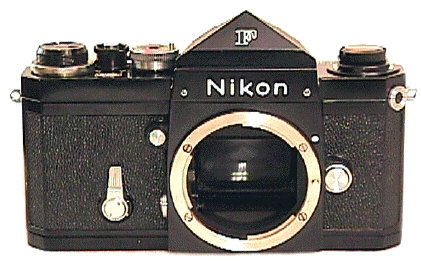
Serial Numbers
Many people think the first two
digits of the F serial number indicates year of manufacture. Not Quite. Beware
of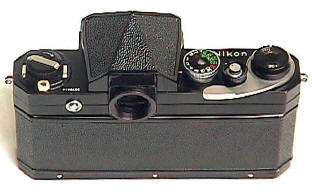 any source which claims the serial # indicates
production year, like a well known but often poorly researched Nikon
"compendium" for instance.
any source which claims the serial # indicates
production year, like a well known but often poorly researched Nikon
"compendium" for instance.
The F started production in 1959. The serial # of the first F was 6400001. So the years and the bodies don't match to begin with. By 1967, to the end of production in May of 1974, serial numbers COINCIDENTALLY matched at least part of the time the year of manufacture. It was a rough match, not an exact one.
Nikon F production ended after 862,600 F's were made. Last number was 7451052. Note not all serial blocks were used.
Like a Hockey Puck
All of this wouldn't make any difference if the Nikon F was not a very dependable camera. Professionals wanted to earn their living, not visit their repair shop.
Nikon F's quickly earned a reputation in the field as being a near indestructible camera. In the words New York's famous camera repair man Marty Forcher "it's a hockey puck."
Whether the F is actually more rugged than the F2 or F3 or F4 or F5 is a question that I will leave for others. I'm not sure anyone could really prove it one way or the other. What I am sure of is that the Nikon F is VERY rugged and reliable--that's enough for me.
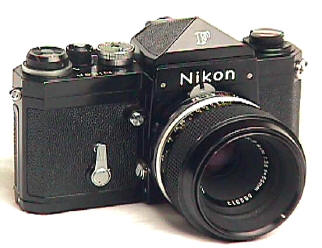
One of the Most Memorable Nikon F ads of the late 60's was "Today, there is almost no other choice."
Revised: November 25, 2003 . Copyright � 1998-2002 Stephen Gandy. All rights reserved. This means you may NOT copy and re-use the text or the pictures in ANY other internet or printed publication of ANY kind. Information in this document is subject to change without notice. Other products and companies referred to herein are trademarks or registered trademarks of their respective companies or mark holders.